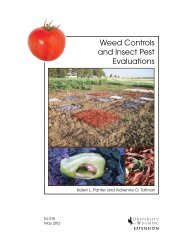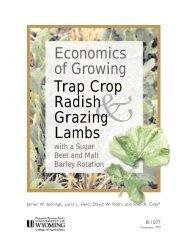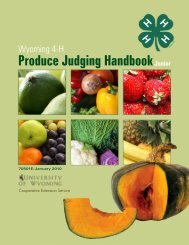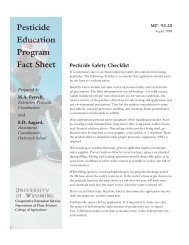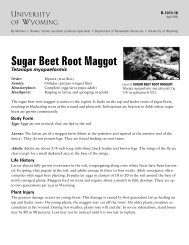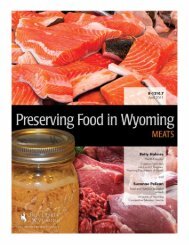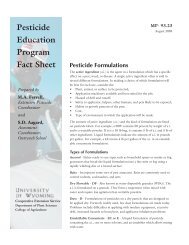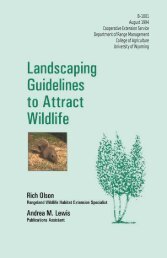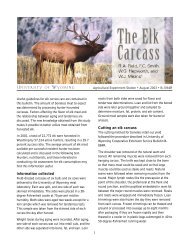animal drinks. <strong>Water</strong> intake is technically defined as freedrinkingwater plus the amount contained in feedstuffs;however, <strong>for</strong> purposes of simplicity in this report, wehave assumed animals are consuming air-dried hay orsenescent <strong>for</strong>age with a minimal (10%) water contentand will use the term “intake” to describe the amountof water consumed voluntarily by animals from streams,ponds, etc. The amount an animal drinks is determinedby true thirst and appetite. By definition, true thirst isthe physiologic drive to consume sufficient water to meetminimum metabolic needs; however, most animals alsoexhibit an “appetite” <strong>for</strong> water and consume more than isstrictly necessarily to satisfy thirst. 7 Reasons <strong>for</strong> the latterare many, varied, and do not lend themselves to quantitativeprediction. We there<strong>for</strong>e disregarded appetite incalculating doses from water intake but instead used fairlyconservative estimates of thirst in such calculations bydisregarding <strong>for</strong>age water content. Most calculations ofpotential toxic doses in this report are thus based upon273 kg (600 lb) feeder cattle that drink approximately20% of their body weight, or about 8 L per kg of dietarydry matter, per day, at 32 C (90 F). This may not provideadequate protection <strong>for</strong> high-producing dairy cattle,which drink significantly more under similar environmentalconditions, but is reasonably conservative <strong>for</strong>range livestock (beef and sheep) and weather conditionstypical of <strong>Wyoming</strong>. Higher temperatures would also resultin higher consumption than our “standard” steer, butsustained periods of such weather are not that commonin <strong>Wyoming</strong>. 8 Finally, there is virtually no in<strong>for</strong>mation onwater consumption by the major wildlife species coveredin this report, but it is reasonable to assume that speciesthat evolved in the northern Great Plains would not havegreater requirements than domestic cattle.This report is targeted at domestic livestock and wildlife(beef cattle, horses, sheep, deer, elk, and pronghornantelope) that rely upon wells, ponds, streams, and otherwater sources on <strong>Wyoming</strong>’s ranges. Although we havemade note of data related to swine where we found them,virtually all modern swine are raised in intensive operationsthat draw water from systems (municipal, waterdistrict, etc.) that are maintained according to humandrinking water standards. Similarly, “alternative agricultural”species such as llamas and bison are not included,in part because of a scarcity of data.<strong>Water</strong> quality is commonly evaluated by chemicalmethods that have been designed to be very reproducibleand very specific. As a result, the process of analyzingwater is fairly straight<strong>for</strong>ward, and many tests are readilyavailable, commercially. Un<strong>for</strong>tunately, translating thesevery precise, <strong>for</strong>mal, data to practical recommendations<strong>for</strong> livestock and wildlife is less cut and dried. As notedby Dr. Art Case, the dean of veterinary toxicologists,“sometimes the cow just didn’t read the book.” First,many toxicants in water act additively with the sametoxicant in feedstuffs. In most such cases, the bottomline is not necessarily the water concentration but ratherthe total mg of toxicant ingested per kg of the animal’sbody weight (commonly expressed as “mg X/kg BW”).Throughout this report, we have tried to use realistic estimatesof total dietary concentrations of such toxicants tocalculate the water concentration of the toxicant requiredto potentially cause problems.Second, chemical water quality tests do not usuallymeasure the specific chemical <strong>for</strong>m of the toxicant present.For example, Se as selenite or selenate behaves quitedifferently in the mammalian body than does selenomethionine,but the typical laboratory just reports total Se.Where possible, we have based recommendations uponthe chemical <strong>for</strong>m most likely to be present in typicalsurface waters in <strong>Wyoming</strong> and noted any caveats thatshould be considered if the water source is not “typical”.In the absence of other data, we have assumed the freeion in water is equivalent on a mg/kg BW basis to thesame chemical in feedstuffs.Third, typical chemical tests do not differentiate betweenanimal species. Some substances are more toxic in ruminantsthan monogastrics (simple-stomached animals) asa result of their unique physiology; some are less. Whilewe have tried to identify significant differences wherethey exist, our recommendations are based upon themost sensitive of our species of interest.Fourth, many toxic substances interact with othertoxicants and/or nutrients in the diet. We have tried toenumerate such interactions in the narrative if they arewell documented and, where possible, account <strong>for</strong> themin the “bottom line” calculations of acceptable waterconcentrations.Finally, the rate of exposure influences the potency ofmany toxicants. A bolus dose of nitrate (NO 3), givenvia a stomach tube, is much more toxic than the sameamount spread over an entire day’s grazing. Undersummer range conditions typical of the Great Plains,livestock drink once, or, at most, twice a day. <strong>Wildlife</strong>typically trek to water and drink their fill during themorning and evening twilight. We have, there<strong>for</strong>e,assumed all of the water-borne daily dose of a given2
substance will be consumed during a fairly short period,once or twice a day.<strong>Water</strong> quality constituents in this report were drawn fromcommon water quality guidelines, prioritized accordingto how closely, in our experience, existing <strong>Wyoming</strong>concentrations approached these guidelines and howoften the elements in question caused poisoning in<strong>Wyoming</strong> animals. For example, Hg is much more toxicthan many of the elements we studied, but it is rarelypresent at detectable concentrations in <strong>Wyoming</strong> watersurveys. Copper is a real problem in aquatic organisms,but Cu deficiency is a much bigger problem in livestockthan Cu toxicity. We then worked our way as far downthis prioritized list as time permitted. Obviously, thereare more constituents on our list than we were able toexamine, but we believe we covered those most importantto <strong>Wyoming</strong>.Data used in compiling this report are drawn primarilyfrom scientific literature, including refereed journals,texts, proceedings, abstracts, and theses, with an emphasison material published during the last 20 years. The basicstrategy consisted of 1) searching biomedical databases(e.g. Medline, CAB Abstracts, etc.) <strong>for</strong> reports of toxicityin any species, 2) examining bibliographies of relevantpapers <strong>for</strong> new leads, and, finally 3) <strong>for</strong>ward searching(e.g. Science Citation Index) <strong>for</strong> more recent papers thatcite earlier work on a given topic. We also solicited welldocumentedanecdotal data (i.e. field reports) from colleaguesat other research and/or diagnostic institutions.Where possible, we tried to validate secondary sources(e.g. reviews, texts) by examining primary documentsfrom which they were drawn. If sufficient data existed <strong>for</strong>our principle species of interest (beef cattle, horses, sheep,elk, deer, and antelope) we focused on those reports. Ifnot, we attempted to extrapolate from rodents, humans,etc., being careful to identify the uncertainty factors inherentin such extrapolations. Each source was assigneda rating <strong>for</strong> reliability, with peer-reviewed, experimentalstudies usually, but not always, being considered morereliable.As noted previously, the interaction of water quality andanimal health is considerably more complex than just“X” mg of “Y” per L of water. For example, many factorshave been suggested to influence the palatability of water<strong>for</strong> animals. Decreased consumption due to bad tasteis potentially just as harmful as water deprivation 3 , yetthe state of the art regarding palatability is still largelyqualitative and anecdotal. Acid pH may mobilize toxicmetals from plumbing or soil, but the particular effectof a given pH is obviously very dependent on the localsituation. A sudden transition to pure water after severalweeks on highly saline water may result in so-called “saltpoisoning.” Where adequate, quantitative data exists <strong>for</strong>non-directly toxic adverse effects on health, we have incorporatedthem into the final recommendations. Wherethere is substantial evidence suggesting such effects exist,but no reproducible, quantitative data were available, wetried to mention the existence of such effects but have notfactored them into the final recommendations.Safety margins are a matter of judgment rather thanan exact science. The purpose of safety margins is tocompensate <strong>for</strong> unknown, or unknowable, variables intoxicology data such as genetic variability, sex, life stage,duration of exposure, un<strong>for</strong>eseen interactions with othertoxicants, etc. The standard practice in setting humandrinking water standards <strong>for</strong> non-carcinogens has been todivide the geometric mean of the NOAEL and minimumtoxic dose by 10 to 1,000 depending upon whetherthe data are derived from human exposure, multiplenon-human species, or incomplete data in any species.Another approach used in the past has been to set the safelimit at the upper end of the range commonly reportedin natural waters as was done with Se. 2 Both approaches,while unarguably “safe,” ignore the realities of livestockproduction in the western United States. <strong>Water</strong> that is so“perfect” as to meet these theoretically desirable criteriahas already been taken <strong>for</strong> other uses. In this report wehave taken the approach of presenting our best estimateof the NOAEL (i.e. will not produce any measurabledecrease in per<strong>for</strong>mance in the most sensitive class ofanimal) under a very conservative set of assumptionsappropriate to <strong>Wyoming</strong> and allowing readers to maketheir own judgment regarding “safety” margins.The final report, together with the documents it wasdrawn from, was <strong>for</strong>warded to colleagues at four otheruniversities (Washington State University, Universityof Nebraska, North Dakota State University, and TexasA&M University) <strong>for</strong> peer review. Their comments wereconsidered and incorporated into the final document.Although there are many ways of expressing measurementsregarding water quality and toxicology, we havechosen to use the following conventions. The dose of atoxicant that causes some particular effect is expressed inmilligrams of substance per kilogram of body weight or“mg X/kg BW”. The concentration of a substance in wateris expressed as milligrams of substance per liter of wa-3
- Page 1 and 2: Water Qualityfor Wyoming Livestock
- Page 3: AbbreviationsADG - average daily ga
- Page 6 and 7: 7 pH 31Function. . . . . . . . . .
- Page 10 and 11: ter or “mg X/L”. If the substan
- Page 12 and 13: tion between the erythrocytic and p
- Page 14 and 15: in diseases such as cancer. 10,20,2
- Page 17 and 18: 3 BariumBarium (Ba), an alkaline ea
- Page 19 and 20: exposed to 100 mg Ba 2+ /L had depr
- Page 21 and 22: 4 FluorideFluorine (F) is the most
- Page 23 and 24: lost weight and many died at the hi
- Page 25: Our search of the literature pertai
- Page 28 and 29: elatively stable; however, once unb
- Page 30 and 31: supplementing with 17 ppm Cu for si
- Page 32 and 33: not transport oxygen from the lungs
- Page 34 and 35: Winter and Hokanson 381 fed varying
- Page 37 and 38: 7 pHpH is defined as “the negativ
- Page 39: for basic drinking water. From a pu
- Page 42 and 43: efficiency. 436,437 Absorption of S
- Page 44 and 45: significantly impaired in the same
- Page 47 and 48: 9 Sodium ChlorideSodium chloride (N
- Page 49 and 50: containing 15,000 mg NaCl/L for 21
- Page 51 and 52: 10 SulfurSulfur (S) occurs in natur
- Page 53 and 54: in feed or water consumption. The a
- Page 55 and 56: 11 Total Dissolved Solids (TDS)Tota
- Page 57: 12 SummaryElementShort (days - week
- Page 61 and 62:
14 Bibliography1. National Research
- Page 63 and 64:
35. Klug H.L., Lampson G.P. and Mox
- Page 65 and 66:
69. Harding J.D., Lewis G. and Done
- Page 67 and 68:
104. Choudhury H. and Cary R. (2001
- Page 69 and 70:
136. Boyd E.M. and Abel M. (1966).
- Page 71 and 72:
171. Mullenix P.J., Denbesten P.K.,
- Page 73 and 74:
203. Schultheiss W.A. and Van Nieke
- Page 75 and 76:
237. Tolgyesi G. and Elmoty I.A. (1
- Page 77 and 78:
269. ANZECC (2000). Australian and
- Page 79 and 80:
301. Huber J.T., Price N.O. and Eng
- Page 81 and 82:
332. Crowley J.W., Jorgensen N.A.,
- Page 83 and 84:
366. Walker R. (1990). Nitrates, ni
- Page 85 and 86:
399. Wu L., Kohler J.E., Zaborina O
- Page 87 and 88:
432. Naftz D.L. and Rice J.A. (1989
- Page 89 and 90:
464. Glenn M.W., Jensen R. and Grin
- Page 91 and 92:
498. Knott S.G. and McCray C.W.R. (
- Page 93 and 94:
532. Harvey R.W., Croom J. WJ, Pond
- Page 95 and 96:
567. Koletsky S. (1959). Role of sa
- Page 97 and 98:
602. Gooneratne S.R., Olkowski A.A.
- Page 99 and 100:
633. McAllister M.M., Gould D.H., R



